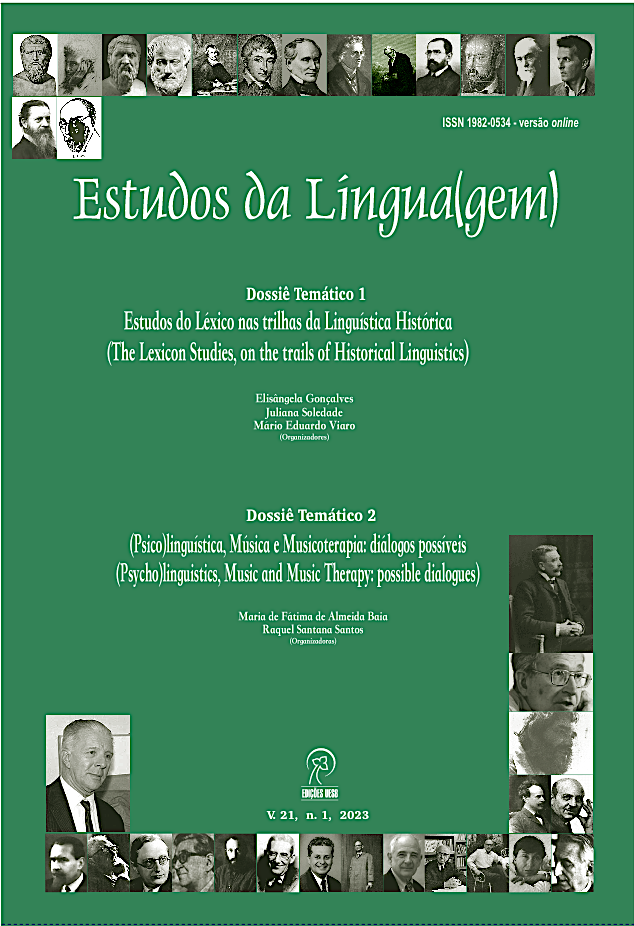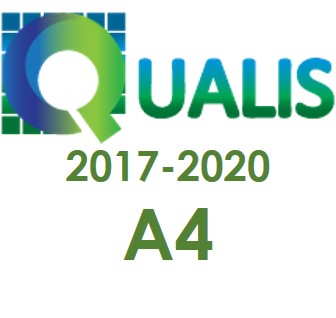Neurologic music therapy: what does that have to do with language?
DOI:
https://doi.org/10.22481/el.v21i1.13388Keywords:
Music; Language; Communication; Neurologic music therapy; Therapy.Abstract
We are all born with speaking and singing abilities, both of which are necesessary for a full life. Neuroscience research development has evolved a lot in the last thirty years. Neuroimaging techniques, electrophysiological research and studies using different theoretical models have allowed progress in language studies, in order to enable the understanding of the different aspects that involve its acquisition, understanding and processing. It has also shown that music is processed in virtually the entire brain. This article aims at showing some aspects that demonstrate the importance of these abilities in the communication processes, their possible relationships, and how the motor deficits of language can be treated with neurologic music therapy.
Downloads
References
ABELA, R. La musicoterapia em la neuroreabilitación. In: Del Moral, M.; Mercadal-Brotons, M.; Sabbatella, P. (Orgs.). Un Studio Descriptivo sobre el Perfi del Musicoterapeuta en España. Bilbao: M.I.-C.I.M. p.7-13; 2015
ALMEIDA, S.S. Chomsky e a linguagem: um estudo acerca da teoria inatista. Revista Ibero-Americana de Humanidades, Ciências e Educação. São Paulo, v.7. n1, janeiro de 2021.
ALTENMÜLLER, E.; SCHLAUG, G. Apollo’s gift: new aspects of neurologic music therapy. Progress in brain research, vol. 217, p. 237-52, 2015.
ALTENMÜLLER, E.; SCHLAUG, G. Neurologic music therapy: the beneficial effects of music making on neurorehabilitation. Acoustical Science and Technology, v. 34, n. 1, p. 5-12, 2013.
BELIN, P.; VAN EECKHOUT, P.; ZILBOVICIUS, M. Recovery from non-fluent aphasia after melodic intonation therapy. Neurology, v.47, p. 1504-1511, 1996.
BENENZON, R.O. Manual de musicoterapia. Rio de Janeiro: Enelivros Editora e Livraria, 1985.
BLOOD, A. J.; ZATORRE, R.J. Intensely pleasurable responses to music correlate with activity in brain regions implicated in reward and emotion. Proceedings of the National Academy of Sciences. v. 98, issue 20, p. 11818-11823, 2001.
BRADSHAW, J. L.; NETTLETON, N. C. Human cerebral asymmetry. Englewood Cliffs, N. J. Prentice Hall, 1983.
BRIGHT, R. Music in geriatric care. A second look. Wahroonga: Music Therapy Entreprise, 1991.
CHATTERJEE, D.; HEGDE, S.; THAUT, Michael. Neural plasticity: The substratum of music-based interventions in neurorehabilitation. NeuroRehabilitation, n. Preprint, p. 1-12, 2021.
CORREIA, C.M.F. Funções musicais, memória musical emocional e volume amigdaliano na doença de Alzheimer. Orientador: Prof. Dr. Paulo Henrique Ferreira Bertolucci. 163 folhas. Tese de doutorado. Universidade Federal de São Paulo- Escola Paulista de Medicina. São Paulo, 2010.
CORREIA, C. M. F. Tratamento não farmacológico: música com pacientes agitados durante a alimentação. In: PIVI, G. A. K.; SCHULTZ, R. R.; BERTOLUCCI, P. H. F. (orgs). Nutrição em demência. 1ªed. São Paulo: SCIO Conteúdo Colaborativo Ltda. 2013.
CRAMER, S. C.; SUR, M.; DOBKIN, B. H.; O’brien, C.; SANGER, T. D.; et al. Harnessing neuroplasticity for clinical applications. Brain, v. 134(Pt 6), p. 1591-1609, 2011
DALLA BELLA, S. et al. (Ed.). The Neurosciences and Music III: Disorders and Plasticity, Volume 1169. John Wiley & Sons, 2009.
DAMASIO, A. R. Aphasia. New England Journal of Medicine, v. 326, n.8, p. 531-539, 1992.
DAMASIO, A. R.; DAMASIO, H. Aphasia and the general basis of language. In: Mesulam, M. M. (Org.). Principles and behavioral and cognitive neurology. 2ª Ed. Nova York: Oxford University Press, 2000.
DIYA, C.; SHANTALA, H.; THAUT, M.; The substratum of music-based interventions in neurorehabilitation. Neurorehabilitation, v. 48, p. 155–166, 2021.
FACHNER, J. The future of music therapy and neuroscience. In: Dileo C. Envisioning the future of music therapy. Philadelphia, Temple University, 2016.
FIORIN, J. L. A linguagem humana: do mito à ciência. Linguística, p. 13-46, 2013.
FITCH, W.; MARTINS, M. D. Hierarquical processing in music, language, and action. Lashley revisited. Ann NY Acad Sci, v. 1316, p. 87-104, 2014.
FONTANESI, S. R. O.; SCHMIDT, A. Ensino de relações condicionais por pareamento auditivo-visual e exclusão para uma idosa com afasia fluente. Acta Comportamentalia: Revista Latina de Análisis de Comportamiento, v. 27, n. 1, p. 73-89, 2019.
FRANCHETO B.; LEITE Y. Origens da linguagem. Rio de Janeiro: Jorge Zahar Editor, 2004.
GALINSKA, E. Music therapy in neurological rehabilitation settings. Psychiatr. Pol, v. 49, issue 4, p. 835–846, 2015.
HABIB, M.; BESSON, M. What do music training and musical experience teach us about brain plasticity?. Music Perception, v. 26, n. 3, p. 279-285, 2009.
HELM-ESTABROOKS, N.; ALBERT, M.L. Manual de la afasia. 2a. ed. Buenos Aires; Madrid: Médica Panamericana, 2005.
HÜBNER, L. C.; WILSON, M. A.; BRAMBATI, S. M. Linguagem na perspectiva da Psico/Neurolinguística e da Neurociência Cognitiva. Letras de Hoje (Porto Alegre), v. 53, n. 1, p. 1-2, jan.-mar. 2018. http://dx.doi.org/10.15448/1984-7726.2018.1.30997 Acessado em: 03 nov. 2021.
JACKUBOVICZ, R. Introdução à afasia. Rio de Janeiro, Revinter, 1996.
JÄNKE, L. Music drives brain plasticity. F1000 Biol Rep, p. 1-78, 2009.
JAUSET-BERROCAL, J. A.; SORIA-URIOS, G. Neurorrehabilitación cognitiva: fundamentos y aplicaciones de la musicoterapia neurológica. Rev Neurol, v. 67, p. 303-10, 2018. Acesso pelo www.neurologia.com Acessado em: 13 nov. 2021.
KOELSCH, S. Towards a neural basis of music-evoked emotions. Trend in Cognitive Sciences. Vol. 14; Nº3, p. 131-137, 2010.
KOELSCH, S. Music and the brain. In J. Rentfrew & D. Levitin (Orgs.). Foundations in music psychology. Cambridge, MA: MIT Pres, 2019. p. 407-458.
KRAUS, N.; SLATER, J. Music and language: relations and disconnections. Handbook of clinical neurology, v. 129, p. 207-222, 2015.
LEVITIN, D. J.; TIROVOLAS, A. K. Current Advances in the Cognitive Neuroscience of Music. Ann. N.Y. Acad, Sci. V. 1156, issue 211-231, 2009.
LICHTENSTEJN, M. Música & Medicina. La aplicación especializada de la música em el área de la salud. Buenos Aires: Elemento, 2009.
LIM, K. B; KIM, Y. K.; LEE, H. J.; YOO, J.; HWANG, J. Y.; KIM, J. A.; KIM, S. K. The therapeutic effect of neurologic music therapy and speech language therapy in post-stroke aphasic patients. Annals of rehabilitation medicine, v. 37, n. 4, p. 556, 2013.
MARTÍNEZ, A. M. G. La música en el tratamiento de patologías físicas y psíquicas. AV NOTAS Revista de Investigación Musical, v 4, p. 23-33, 2018. Recuperado de: http://publicaciones.csmjaen.es/index.php/pruebas/article/view/127/103
MIRANDA, M.C.; HAZARD, S. O.; MIRANDA, P.V. La música como una herramienta terapéutica en medicina. Rev. chil. neuro-psiquiatr., v. 55, n. 4, p. 266-277, 2017.
MUSZKAT, M.; MELLO, C. B. Linguagem. In: _____. Neuropsicologia. Do desenvolvimento e suas interfaces. Vol.1. São Paulo: All Print, 2008; p.174-186.
NETO, J. B. Música é linguagem? Revista eletrônica de musicologia, v. 9, 2005.
BRADSHAW, J. L, NETTLETON, N. C. Human Cerebral Asymetry. New Jersey: Prentice-Hall; 1983.
NOBOA, C. J. La musicoterapia neurológica como modelo de neurorreabilitación. Rev. Ecuat. Neurol. Vol. 27, No 1, 2018.
O'KELLY, J.; FACHNER, J. C.; TERVANIEMI, M. Dialogues in music therapy and music neuroscience: Collaborative understanding driving clinical advances. Frontiers in human neuroscience, v. 10, Artigo 585; p.1-4, 2016.
ORTI, J.E.R.; ESPINÓS, E.S.; IRANZO, C.C. Impacto fisiológico en la depresión, ansiedad, y bienestar del paciente com demência tipo Alzheimer. Valoración de la utilización de cuestionarios para cuantificarlo. Eur. J. investig. health psychol. educa, v. 4, n. 2, p. 131-140, 2014.
ORTIZ, K. Z. Afasia. In: ORTIZ, K. Z. (Org.), Distúrbios Neurológicos Adquiridos: linguagem e cognição. (2ª. ed.). Barueri, SP: Manole, 2010.
PATEL, A.D. Music, language and the brain. Oxford University Press. 2007.
PERETZ, I.; DOMINIQUE V.; LAGROIS, M. E.; ARMONY, J. L. Neural overlap in processing music and speech. Philosophical Transactions of the Royal Society B: Biological Sciences, v. 370, n. 1664, p. 20140090, 2015.
PFEIFFER, C. F. Nusicoterapia en la neurorehabiltación de adultos: evidencias científicas y desafios de la práctica clínica. Revista InCantare v.11, n.2; p.37-57, jul./dez. 2019.
RUUD, E. Caminhos da musicoterapia. São Paulo: Summus Editorial, 1990.
SCHLAUG, Gottfried et al. From singing to speaking: facilitating recovery from nonfluent aphasia. Future neurology, v. 5, n. 5, p. 657-665, 2010.
SENAHA, M.L.H.; MACHADO, T.H. Afasias, Dislexias e Disgrafias. In: TEIXEIRA, A. L. & Caramelli P. Neurologia Cognitiva e do Comportamento. Rio de Janeiro: Revinter, 2012. p. 99-108.
SILVA, G. C.; LUFT, M. G. Discussões acerca das relações sociais promovidas pelo uso da linguagem humana. Web-Revista SOCIODIALETO – NUPESD/LALIMU, v.10, nº29, nov 2019.
SOUZA JUNIOR, A.S. Algumas considerações acerca de uma provável origem da linguagem: entre o biológico e o social. Revista Philologus, Ano 25, N° 73. Rio de Janeiro, 2019.
STAHL, B.; KOTZ, S. A.; HENSELER, I.; TURNER, R.; GEYER, S. Rhythm in disguise: why singing may not hold the key to recovery from aphasia. Brain, v. 134, p. 3083- 3093, 2011.
STEWARD, M.; MIGNONE, F. História da Música Contada à Juventude. São Paulo, Editorial Mangione S.A., 1935.
STERNBERG, R.J. Psicologia cognitiva. Porto Alegre: Artmed Editora, 2000.
TALERO-GUTIÉRREZ, C.; ZARRUK-SERRANO, J. G,; ESPINOSA-BODE, A. Percepción musical y funciones cognitivas. Existe el efecto Mozart? Rev Neurol, v. 39, issue 12, p. 1167-1173.
TAYLOR, D.B. Biomedical Foundation of Music as Therapy. Saint Louis: MMB Music, Inc.; 1999.
THAUT, M. H. Velocity Modulation and Rhythmic Synchronization of Gait in Huntington’s Disease. Movement Disorders, Vol. 14, No. 5, p. 808–819, 1999.
THAUT, M. H.; PETERSON, D.A.; MCINTOSH, C. Temporal entrainment of cognitive functions: Musical mnemonics induce brain plasticity and oscillatory synchrony in neural networks underlying memory. Annals of the New York Academy of Sciences, v. 1060, n. 1, p. 243-254, 2005.
THAUT, M. H.; PETERSON, D.A.; SENA, K.M.; MCINTOSH, G.C. Musical structure facilitates verbal learning in multiple sclerosis. Music Perception, v. 25, n. 4, p. 325-330, 2008.
THAUT, M. H. How Music Helps to Heal the Injured Brain: Therapeutic Use Crescendos Thanks to Advances in Brain Science By Michael H. Thaut, Ph. D., and Gerald C. McIntosh, MD. Cerebrum, 2010.
THAUT, M.; HOEMBERG, V. Handbook of neurologic music therapy. Oxford University Press (UK), 2014.
THAUT, M. H.; MCINTOSH, G. C. Neurologic music therapy in stroke rehabilitation. Current Physical Medicine and Rehabilitation Reports, v. 2, n. 2, p. 106-113, 2014.
TOMAINO, C. M. Musicoterapia Neurológica: evocando as vozes do silêncio. São Leopoldo: Faculdades EST, 2014.
TOMAINO, C. M, . Music on their minds: A qualitative study of the effects of using familiar music to stimulate preserved memory function in persons with dementia. New York University, 1998.
YU, M.; XU, M.; LI, X.; CHEN, Z.; SONG, Y.; LIU, J. The shared neural basis of music and language. Neuroscience. v. 357, p. 208-219, 2017.
WEINBERGER, N. Music and the brain. Scientific American Special Ed. Secrets of senses. v. 16, n. 3, 2006.
Downloads
Published
How to Cite
Issue
Section
License

This work is licensed under a Creative Commons Attribution 4.0 International License.

Estudos da Língua(gem) is licensed under a Creative Commons Attribution 4.0 International License.
Authors who publish in the journal Estudos da Língua (gem) agree with the following terms:
The journal Estudos de Língua(gem) maintains the copyrights of the contributions published. These rights include the publication of the contribution and make its content available for free through the portal.







